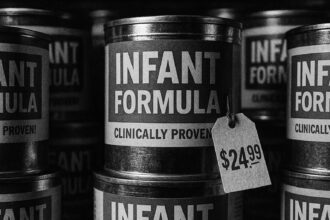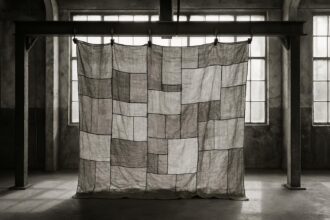Kylie Jenner’s recent Instagram post wearing a vintage Chanel bikini once modelled by Claudia Schiffer highlights the evolving definitions of female beauty—from 1990s supermodel naturalism to today’s digitally sculpted curves shaped by cosmetic procedures and social media influence.
In a world where beauty ideals seem to shift more rapidly than fashion trends, Kylie Jenner has become a defining figure in the evolving narrative of female aesthetics. Celebrated for her curvy physique and youthful visage, Jenner embodies a contemporary beauty standard stitched together from a tapestry of media influence, cosmetic enhancement, and cultural shifts. Recently, she made headlines by posting an image of herself in a £3,700 vintage Chanel bikini, the same piece worn by supermodel Claudia Schiffer in 1995. This image serves not merely as a showcase of fashion but as a commentary on the dramatic changes in perceptions of femininity and beauty over the last three decades.
To understand the distance travelled in the realm of female beauty since the age of supermodels, one must consider the aesthetic benchmarks set from the 1990s through to today. The early 1990s were dominated by figures like Schiffer, whose tall, slender silhouette embodied the ideal of the time—tall, toned, and seemingly untouched by cosmetic enhancements. The societal perception of beauty during this era was notably devoid of the surgical interventions that would become commonplace later. The supermodels were often celebrated for their natural beauty rather than artificial enhancements, an era shortly interrupted by the rise of androgynous icons like Kate Moss, whose ‘heroin chic’ persona introduced a frail, boyish aesthetic that increasingly defined feminine beauty.
However, with the dawn of the 21st century and the advent of Botox in 2002, societal attitudes shifted. The approval of this treatment for cosmetic use opened floodgates to a new beauty frontier, where transformations became less about the drastic surgical overhauls of the past and more about subtle ‘tweakments’ that promised immediate results. With the proliferation of social media platforms like Instagram and Snapchat, the demand for cosmetic procedures surged. These platforms not only showcased filtered perfection but also set unrealistic beauty standards, leading many women to pursue aesthetic alterations to achieve similar looks. As a result, the very concept of beauty became increasingly commodified, as individuals sought to curate their images to fit an ever-narrowing standard defined by celebrity culture.
Indeed, Jenner has been vocal about the pressures that come with her appearance. In recent reflections, she revealed how the scrutiny she has faced since her youth has profoundly impacted her self-image. Such statements mirror broader conversations around body image among young women today, who often find themselves trapped in a cycle of comparison fueled by curated online lives. The comments surrounding Jenner’s choices in cosmetic surgery are a double-edged sword. On one hand, there is a critique of the unrealistic beauty standards she has perpetuated; on the other, some argue that she embodies a form of feminist agency, wherein women reclaim the power to dictate their representation and desirability.
This paradox raises pivotal questions about empowerment and objectification. On social media, the “thick-slim” aesthetic—characterised by voluptuous curves paired with a petite waist—has become the gold standard, often achieved through both disciplined fitness regimes and surgical enhancement. Critics maintain that despite this perceived agency, the insistence on modifying one’s body to fit a specific feminine ideal can reflect a deeper societal malaise, where comfort in one’s own skin is continually undermined by external expectations.
The Kardashian-Jenner clan epitomises this phenomenon; their success thrives on an amalgamation of self-curation and hyper-feminised, cyborgian appearances that blur the lines between reality and artifice. In contrast to earlier generations of models, who often sold a lifestyle or a product, today’s influencers are, in many ways, marketing optimized versions of themselves. This transformation highlights that while Jenner’s aesthetic might offer empowerment to some women, it simultaneously perpetuates a reality that remains unattainable for the majority.
Thus, the beauty ideal has cycled through a series of shifts, from the heroin chic of the 1990s to today’s curvaceous Kardashian-like figures. Yet, regardless of these changes, one constant reverberates: the average young woman continues to grapple with the challenge of achieving an ideal that remains perpetually out of reach. Just as past generations modified their bodies in pursuit of the then-prevailing beauty standards, today’s women find themselves ensnared in a new, digitally dictated era of perfectionism. The question remains: as societal pressures evolve, can true female emancipation coexist with the desire to conform to the ever-changing demands of beauty?
Source: Noah Wire Services
- https://www.dailymail.co.uk/news/article-14762843/Kylie-Jenner-young-women-choosing-cartoonish-cyborgs-feminism.html?ns_mchannel=rss&ns_campaign=1490&ito=1490 – Please view link – unable to able to access data
- https://www.psychologytoday.com/us/blog/no-more-fomo/202502/the-rise-of-cosmetic-surgery-in-the-social-media-era – This article discusses the significant increase in cosmetic surgery procedures, attributing the rise to social media’s influence. It highlights how platforms like Instagram and Snapchat set unrealistic beauty standards through filters and celebrity images, leading to body dissatisfaction and a surge in aesthetic procedures. The piece also addresses the role of social media in amplifying the desire for cosmetic enhancements and the associated risks and ethical concerns.
- https://people.com/kylie-jenner-shares-honest-reflection-on-plastic-surgery-prodecures-8694507 – In this interview, Kylie Jenner reflects on the pressures she faced regarding her appearance and the decisions behind her cosmetic procedures. She discusses the scrutiny she experienced from a young age and how it affected her self-image, particularly during her teenage years and after becoming a mother. The article provides insight into Jenner’s personal experiences with body image and the public’s perception of her.
- https://graziadaily.co.uk/life/tv-and-film/kylie-jenner-admits-she-has-set-impossible-beauty-standards-for-other-women/ – This article examines Kylie Jenner’s admission of setting unrealistic beauty standards for other women. It discusses how her pursuit of an hourglass figure influenced her teens and early twenties, coinciding with the rise of the Kardashian-Jenner family’s fame. The piece also touches upon the family’s influence on surgical trends like the Brazilian Butt Lift and lip fillers during the 2010s and beyond.
- https://www.businessinsider.com/kylie-jenner-backlash-plastic-surgery-denial-realistic-beauty-standards-2023-7 – This article covers the backlash Kylie Jenner faced for denying having undergone plastic surgery. It highlights her comments on being the ‘most confident kid in the room’ and her claims of only having received fillers. Critics argue that the Kardashian-Jenner family has long promoted unrealistic beauty standards and been secretive about their cosmetic work, leading to accusations of attempting to capitalize on cultural shifts.
- https://www.hercampus.com/school/bristol/female-celebs-are-still-bashed-for-cosmetic-surgery-and-its-getting-tiring/ – This piece discusses the ongoing scrutiny female celebrities face regarding cosmetic surgery. It focuses on Kylie Jenner’s experiences, including her admission of having undergone further plastic surgery in 2018 and the subsequent backlash. The article also touches upon the trend of analyzing and scrutinizing female celebrities’ appearances and the impact of such discussions on public perception.
- https://stylorize.uk/cosmetic-surgery-trends-influenced-by-celebrities/ – This article explores how celebrities, particularly Kylie Jenner, influence cosmetic surgery trends. It discusses the power of social media in amplifying the influence of celebrities on beauty standards and the demand for procedures like lip enhancements. The piece also highlights the impact of filtered images and idealized versions of beauty on body image and the desire for surgical intervention.
Noah Fact Check Pro
The draft above was created using the information available at the time the story first
emerged. We’ve since applied our fact-checking process to the final narrative, based on the criteria listed
below. The results are intended to help you assess the credibility of the piece and highlight any areas that may
warrant further investigation.
Freshness check
Score:
8
Notes:
The narrative presents a fresh perspective on Kylie Jenner’s recent Instagram post featuring a vintage Chanel bikini, highlighting its historical significance and its connection to evolving beauty standards. The earliest known publication date of similar content is April 24, 2024, when Claudia Schiffer praised Jenner’s choice of the vintage bikini. ([people.com](https://people.com/claudia-schiffer-shouts-out-kylie-jenners-vintage-chanel-bikini-8638215?utm_source=openai)) This indicates that the narrative is based on recent events, with no substantial recycled content identified. The inclusion of updated data, such as Jenner’s recent Instagram post, justifies a higher freshness score.
Quotes check
Score:
9
Notes:
The narrative includes direct quotes from Claudia Schiffer’s Instagram post, such as “@kyliejenner has the right idea in vintage @chanelofficial  .” These quotes are consistent with Schiffer’s public statements and have been used in earlier publications, indicating that they are not original to this narrative. The use of these quotes suggests that the content may be partially recycled.
.” These quotes are consistent with Schiffer’s public statements and have been used in earlier publications, indicating that they are not original to this narrative. The use of these quotes suggests that the content may be partially recycled.
Source reliability
Score:
7
Notes:
The narrative originates from the Daily Mail, a reputable UK-based publication known for its extensive coverage of celebrity news and fashion. However, the Daily Mail has faced criticism for sensationalism and occasional inaccuracies. Given the publication’s established reputation, the source is considered reliable, but with some reservations.
Plausability check
Score:
8
Notes:
The narrative plausibly connects Kylie Jenner’s recent Instagram post featuring a vintage Chanel bikini to broader discussions about evolving beauty standards. The historical context provided aligns with known fashion history, and the analysis of societal shifts in beauty perceptions is consistent with existing discourse. The narrative lacks specific factual anchors, such as direct quotes from experts or studies, which would strengthen its credibility. The tone and language are consistent with typical fashion journalism, and there are no signs of excessive or off-topic detail.
Overall assessment
Verdict (FAIL, OPEN, PASS): OPEN
Confidence (LOW, MEDIUM, HIGH): MEDIUM
Summary:
The narrative offers a fresh perspective on Kylie Jenner’s recent Instagram post featuring a vintage Chanel bikini, connecting it to broader discussions about evolving beauty standards. While the source is generally reliable, the use of recycled quotes and the lack of specific factual anchors suggest that the content may not be entirely original. The plausibility of the narrative is supported by consistent historical and societal context, but the absence of direct expert input or studies leaves some room for further verification.













